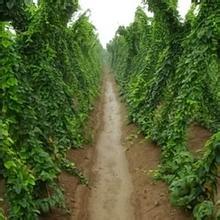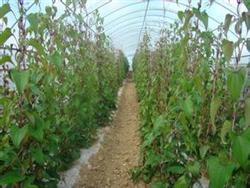Technical specification for pollution-free fertilization of yam cultivation

① propagation technology: the reproduction of Chinese yam can be divided into sexual reproduction and asexual reproduction. Sexual reproduction is mainly used in cross breeding to obtain new varieties with high yield and high quality, but it is generally not suitable for production because it takes a long time. Asexual reproduction includes tuber cutting propagation, terminal bud reproduction and so on. Fertilizer and water management technology is the same as Daejeon. ② field cultivation and fertilization techniques: a. Soil preparation and fertilization, timely planting: the roots absorbed by Chinese yam are shallower and the tubers are deeper. Therefore, the sandy loam or loam soil with deep and loose soil layer and no continuous cropping within 3 years must be selected and planted in high beds or furrows and ridges after the beginning of spring. Because the main absorbing root system of Chinese yam is distributed in the upper soil, the base fertilizer is applied shallowly in the surface soil layer, and the method of planting seed block first and then turning the soil to fertilize is adopted. The base fertilizer should be mixed well with dry dung, plant ash or soil fertilizer. Manure should be rotten first, generally 30000-60000 kg / ha, urea 300-375 kg / ha, calcium superphosphate 225 kg / ha, potassium sulfate 375-525 kg / ha. In order to prolong the field growth period and improve the yield and quality in the areas with short dew period, the method of seedling cultivation and transplanting can be adopted, and the seedlings can be raised in seedling bed by using protective facilities, and then planted in the field in time. B. skillfully applying topdressing: in the early stage, Chinese yam mainly grew in aboveground stems and leaves, while underground stems grew slowly and needed less fertilizer. Therefore, a large amount of rotten manure can be applied from sowing or transplanting to growing, generally applying about 15000 kg / ha of dilute feces and urine at the time of seedling completion or after transplanting. After that, it was applied every 20 to 30 days, and each time the rotten manure and urine fertilizer was applied to 15000kg / ha or 225kg / ha or the ternary compound fertilizer was 225kg / ha. After the budding of the plant, the underground tuber not only elongated rapidly, but also gradually entered the period of enlargement, thickness and weight gain, and the need for fertilizer increased sharply. At this time, the thicker mixture of human feces and urine and cake fertilizer 30000 ~ 60000 kg / ha or three-element compound fertilizer 600 ~ 750 kg / ha should be re-applied. This topdressing is a key fertilizer that has the greatest impact on tuber yield. In the future, when the stem is full of vines, if you find that there is a phenomenon of losing fat, you can chase the fertilizer again, and the dosage is less than the previous one. In the last time, plant growth was observed 40 days before harvest and fertilized once to improve tuber yield and quality. After Frosts Descent, the aboveground stems and leaves are withered and yellow and should be harvested in time.
- Prev

How to select, prepare and fertilize the soil for planting yam?
How to manage yam after planting? From planting to erection, it is necessary to do a good job of weeding by ploughing and weeding, and in the later stage, ploughing should be shallow rather than deep, so as not to hurt the roots. A few days after the emergence of Chinese yam, it is necessary to support the vine immediately. in order to increase the light area, the height should be about 1.5 materials. After sowing until it grows, manure can be applied on the ground.
- Next

Key techniques of Chinese Yam cultivation
The common way of planting Chinese yam is prone to hairy, rough epidermis, bending and bifurcation and other phenomena, which seriously affect the yield and commerciality of Chinese yam. The cultivation of Chinese yam with plastic casing can not only solve the above problems and improve the merchandise of Chinese yam, but also greatly reduce the number of damaged yam with high yield and quality.
Related
- Where is it suitable to grow horseradish in China? it is expected to see the middle altitude horseradish in Alishan.
- How to prevent tomato virus disease reasonably? (Control methods included)
- Many people like to plant towel gourd on the balcony. What are the main points of this method and management?
- What crops can chili peppers be mixed with?
- Fertilization techniques and matters needing attention in Tomato
- What are the grafting techniques for peach seedlings in spring?
- Harm and control methods of root swelling disease of Chinese cabbage
- What are the pests of sweet potatoes? How to prevent and cure it?
- Symptoms, causes and Control methods of navel Rot in Tomato
- The cause of "Cucumber rotten bibcock" in Farmers' planting Cucumber and its Control Plan

